Organisational Behaviour: Impact on Teams and Individuals - 4Com
VerifiedAdded on 2021/02/19
|17
|5369
|37
Report
AI Summary
This report delves into the realm of organisational behaviour, examining its impact on teams and individuals within the context of 4Com plc. The report commences with an introduction to organisational behaviour, emphasizing its importance in managing human resources effectively. Task 1 analyzes how an organisation's power dynamics, political landscape, and cultural environment influence team performance and individual behaviour, utilizing Handy's model of organisational culture and the power models of John French and Bertram Raven. Task 2 explores the application of content and process theories of motivation, including Maslow's hierarchy of needs and Herzberg's Two-Factor Theory, to enhance employee productivity and achieve organisational objectives. Task 3 differentiates between effective and ineffective teams, highlighting the key elements that contribute to team success. Finally, Task 4 discusses the concepts and philosophies of organisational behaviour within an organisational context, summarizing the positive and negative impacts on business. The report concludes with a synthesis of the key findings and recommendations for improving organisational effectiveness.
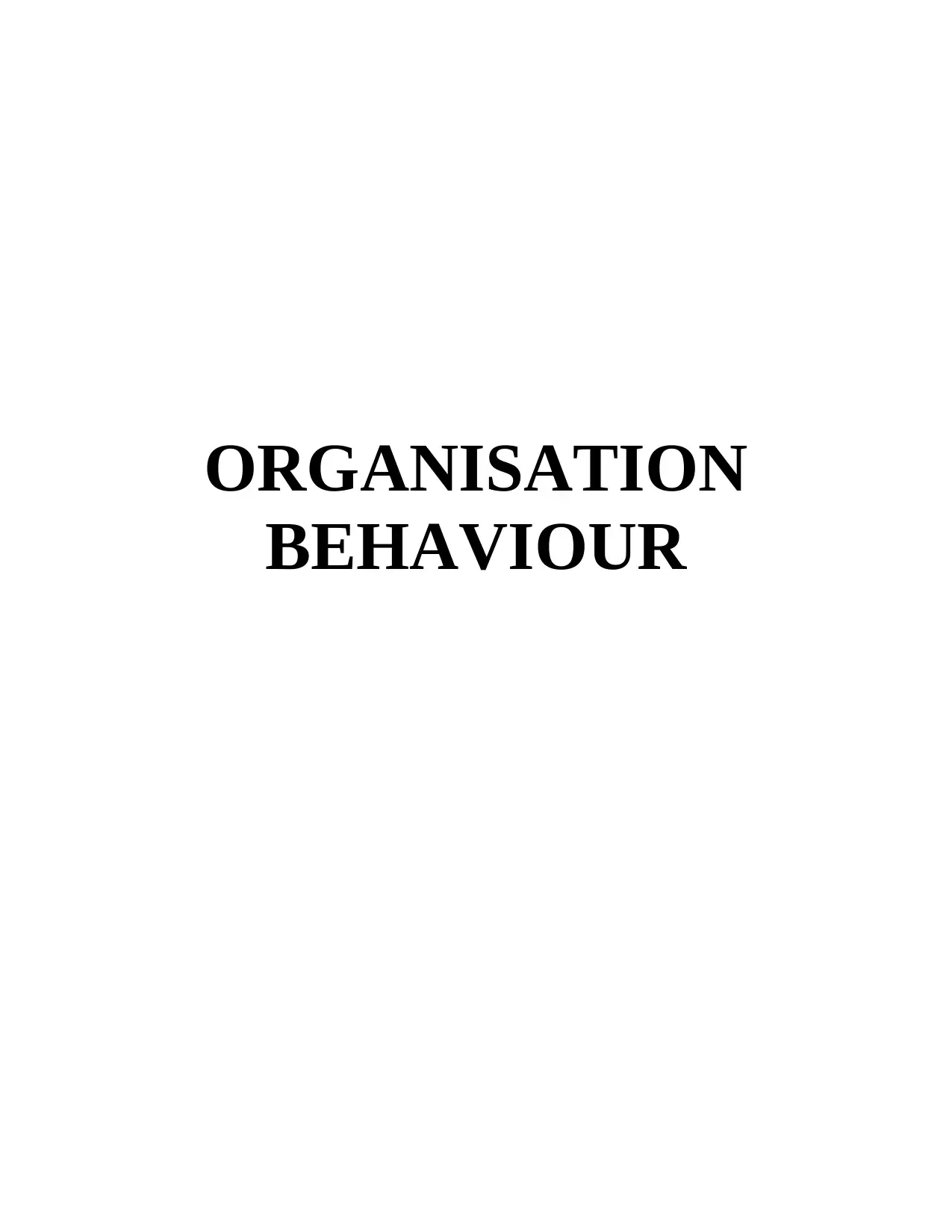
ORGANISATION
BEHAVIOUR
BEHAVIOUR
Paraphrase This Document
Need a fresh take? Get an instant paraphrase of this document with our AI Paraphraser
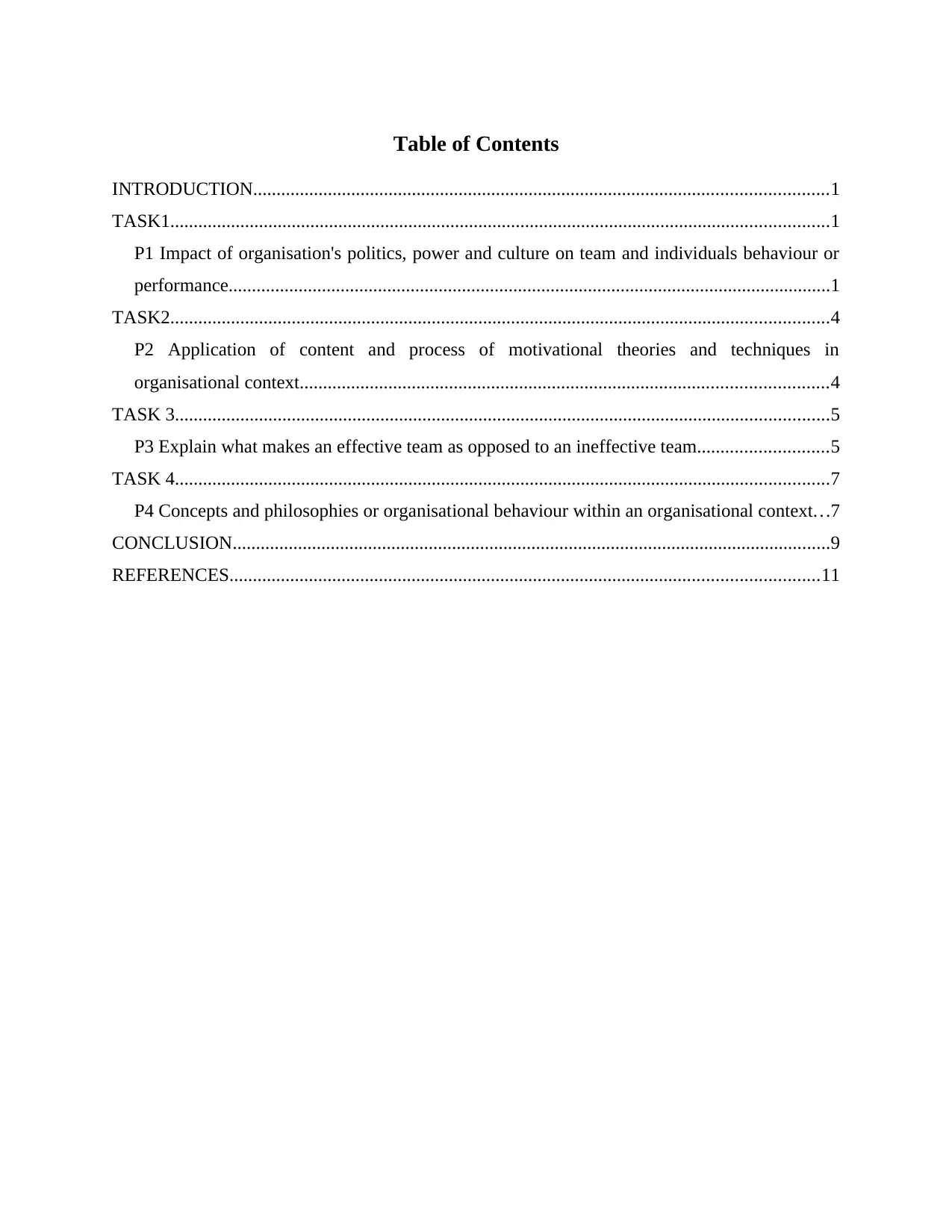
Table of Contents
INTRODUCTION...........................................................................................................................1
TASK1.............................................................................................................................................1
P1 Impact of organisation's politics, power and culture on team and individuals behaviour or
performance.................................................................................................................................1
TASK2.............................................................................................................................................4
P2 Application of content and process of motivational theories and techniques in
organisational context.................................................................................................................4
TASK 3............................................................................................................................................5
P3 Explain what makes an effective team as opposed to an ineffective team............................5
TASK 4............................................................................................................................................7
P4 Concepts and philosophies or organisational behaviour within an organisational context...7
CONCLUSION................................................................................................................................9
REFERENCES..............................................................................................................................11
INTRODUCTION...........................................................................................................................1
TASK1.............................................................................................................................................1
P1 Impact of organisation's politics, power and culture on team and individuals behaviour or
performance.................................................................................................................................1
TASK2.............................................................................................................................................4
P2 Application of content and process of motivational theories and techniques in
organisational context.................................................................................................................4
TASK 3............................................................................................................................................5
P3 Explain what makes an effective team as opposed to an ineffective team............................5
TASK 4............................................................................................................................................7
P4 Concepts and philosophies or organisational behaviour within an organisational context...7
CONCLUSION................................................................................................................................9
REFERENCES..............................................................................................................................11
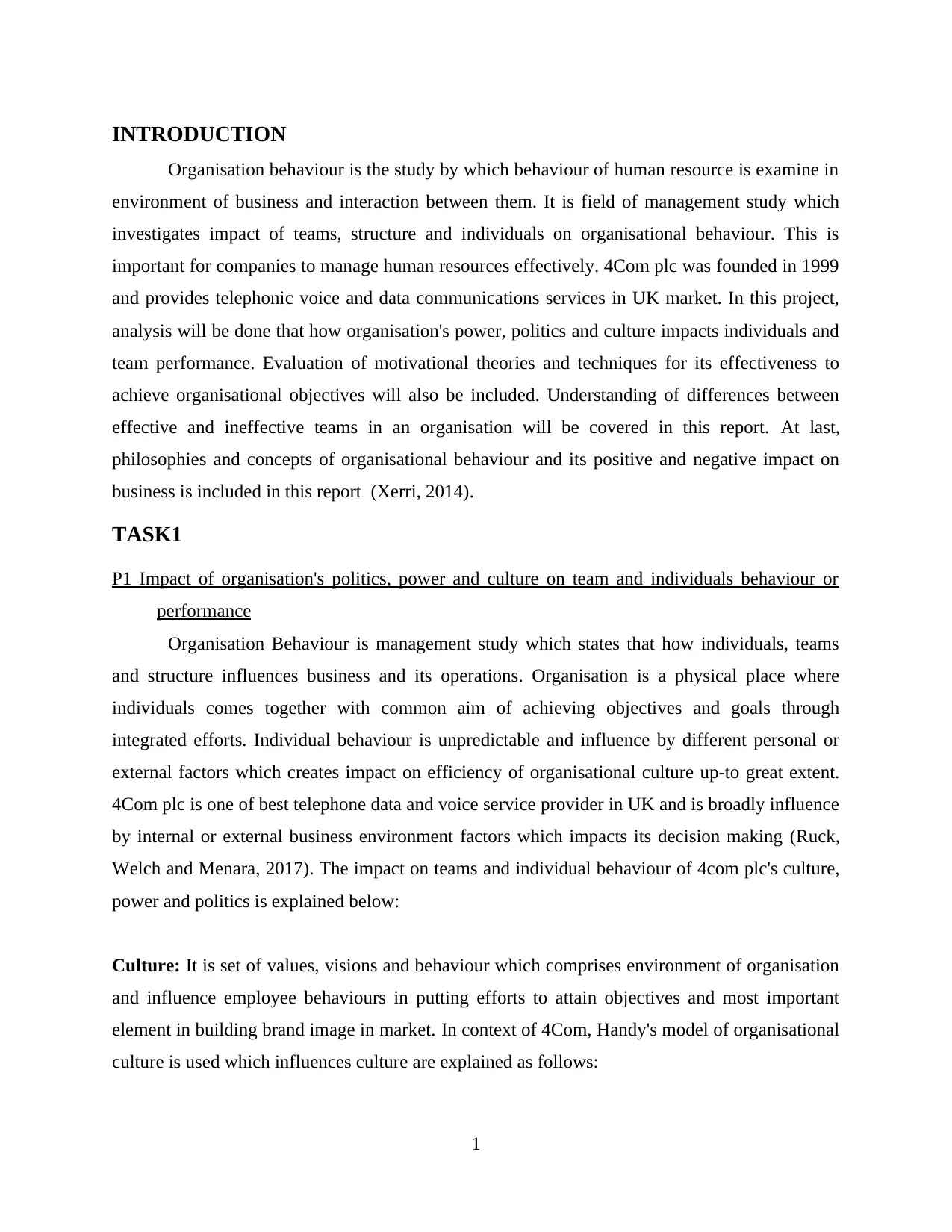
INTRODUCTION
Organisation behaviour is the study by which behaviour of human resource is examine in
environment of business and interaction between them. It is field of management study which
investigates impact of teams, structure and individuals on organisational behaviour. This is
important for companies to manage human resources effectively. 4Com plc was founded in 1999
and provides telephonic voice and data communications services in UK market. In this project,
analysis will be done that how organisation's power, politics and culture impacts individuals and
team performance. Evaluation of motivational theories and techniques for its effectiveness to
achieve organisational objectives will also be included. Understanding of differences between
effective and ineffective teams in an organisation will be covered in this report. At last,
philosophies and concepts of organisational behaviour and its positive and negative impact on
business is included in this report (Xerri, 2014).
TASK1
P1 Impact of organisation's politics, power and culture on team and individuals behaviour or
performance
Organisation Behaviour is management study which states that how individuals, teams
and structure influences business and its operations. Organisation is a physical place where
individuals comes together with common aim of achieving objectives and goals through
integrated efforts. Individual behaviour is unpredictable and influence by different personal or
external factors which creates impact on efficiency of organisational culture up-to great extent.
4Com plc is one of best telephone data and voice service provider in UK and is broadly influence
by internal or external business environment factors which impacts its decision making (Ruck,
Welch and Menara, 2017). The impact on teams and individual behaviour of 4com plc's culture,
power and politics is explained below:
Culture: It is set of values, visions and behaviour which comprises environment of organisation
and influence employee behaviours in putting efforts to attain objectives and most important
element in building brand image in market. In context of 4Com, Handy's model of organisational
culture is used which influences culture are explained as follows:
1
Organisation behaviour is the study by which behaviour of human resource is examine in
environment of business and interaction between them. It is field of management study which
investigates impact of teams, structure and individuals on organisational behaviour. This is
important for companies to manage human resources effectively. 4Com plc was founded in 1999
and provides telephonic voice and data communications services in UK market. In this project,
analysis will be done that how organisation's power, politics and culture impacts individuals and
team performance. Evaluation of motivational theories and techniques for its effectiveness to
achieve organisational objectives will also be included. Understanding of differences between
effective and ineffective teams in an organisation will be covered in this report. At last,
philosophies and concepts of organisational behaviour and its positive and negative impact on
business is included in this report (Xerri, 2014).
TASK1
P1 Impact of organisation's politics, power and culture on team and individuals behaviour or
performance
Organisation Behaviour is management study which states that how individuals, teams
and structure influences business and its operations. Organisation is a physical place where
individuals comes together with common aim of achieving objectives and goals through
integrated efforts. Individual behaviour is unpredictable and influence by different personal or
external factors which creates impact on efficiency of organisational culture up-to great extent.
4Com plc is one of best telephone data and voice service provider in UK and is broadly influence
by internal or external business environment factors which impacts its decision making (Ruck,
Welch and Menara, 2017). The impact on teams and individual behaviour of 4com plc's culture,
power and politics is explained below:
Culture: It is set of values, visions and behaviour which comprises environment of organisation
and influence employee behaviours in putting efforts to attain objectives and most important
element in building brand image in market. In context of 4Com, Handy's model of organisational
culture is used which influences culture are explained as follows:
1
⊘ This is a preview!⊘
Do you want full access?
Subscribe today to unlock all pages.

Trusted by 1+ million students worldwide
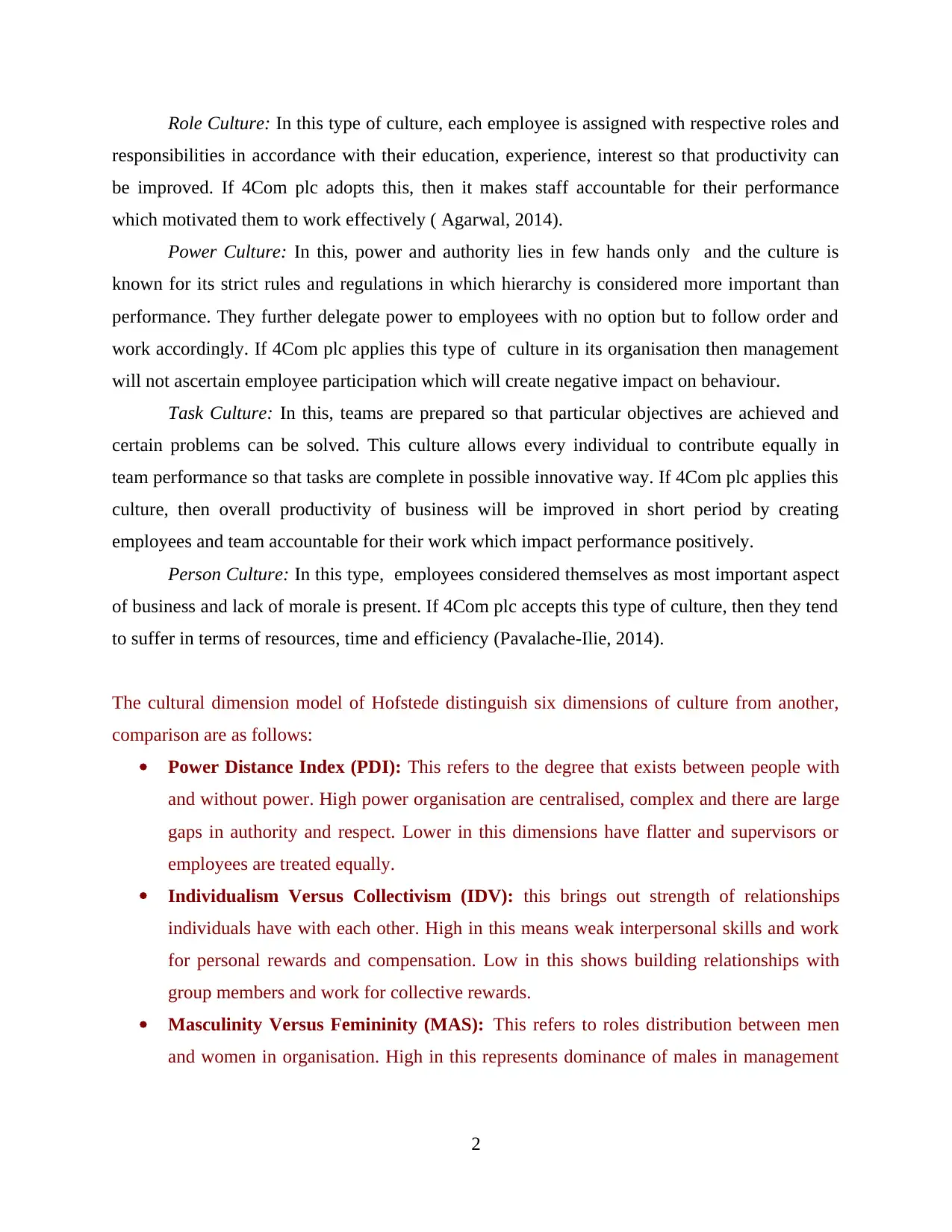
Role Culture: In this type of culture, each employee is assigned with respective roles and
responsibilities in accordance with their education, experience, interest so that productivity can
be improved. If 4Com plc adopts this, then it makes staff accountable for their performance
which motivated them to work effectively ( Agarwal, 2014).
Power Culture: In this, power and authority lies in few hands only and the culture is
known for its strict rules and regulations in which hierarchy is considered more important than
performance. They further delegate power to employees with no option but to follow order and
work accordingly. If 4Com plc applies this type of culture in its organisation then management
will not ascertain employee participation which will create negative impact on behaviour.
Task Culture: In this, teams are prepared so that particular objectives are achieved and
certain problems can be solved. This culture allows every individual to contribute equally in
team performance so that tasks are complete in possible innovative way. If 4Com plc applies this
culture, then overall productivity of business will be improved in short period by creating
employees and team accountable for their work which impact performance positively.
Person Culture: In this type, employees considered themselves as most important aspect
of business and lack of morale is present. If 4Com plc accepts this type of culture, then they tend
to suffer in terms of resources, time and efficiency (Pavalache-Ilie, 2014).
The cultural dimension model of Hofstede distinguish six dimensions of culture from another,
comparison are as follows:
Power Distance Index (PDI): This refers to the degree that exists between people with
and without power. High power organisation are centralised, complex and there are large
gaps in authority and respect. Lower in this dimensions have flatter and supervisors or
employees are treated equally.
Individualism Versus Collectivism (IDV): this brings out strength of relationships
individuals have with each other. High in this means weak interpersonal skills and work
for personal rewards and compensation. Low in this shows building relationships with
group members and work for collective rewards.
Masculinity Versus Femininity (MAS): This refers to roles distribution between men
and women in organisation. High in this represents dominance of males in management
2
responsibilities in accordance with their education, experience, interest so that productivity can
be improved. If 4Com plc adopts this, then it makes staff accountable for their performance
which motivated them to work effectively ( Agarwal, 2014).
Power Culture: In this, power and authority lies in few hands only and the culture is
known for its strict rules and regulations in which hierarchy is considered more important than
performance. They further delegate power to employees with no option but to follow order and
work accordingly. If 4Com plc applies this type of culture in its organisation then management
will not ascertain employee participation which will create negative impact on behaviour.
Task Culture: In this, teams are prepared so that particular objectives are achieved and
certain problems can be solved. This culture allows every individual to contribute equally in
team performance so that tasks are complete in possible innovative way. If 4Com plc applies this
culture, then overall productivity of business will be improved in short period by creating
employees and team accountable for their work which impact performance positively.
Person Culture: In this type, employees considered themselves as most important aspect
of business and lack of morale is present. If 4Com plc accepts this type of culture, then they tend
to suffer in terms of resources, time and efficiency (Pavalache-Ilie, 2014).
The cultural dimension model of Hofstede distinguish six dimensions of culture from another,
comparison are as follows:
Power Distance Index (PDI): This refers to the degree that exists between people with
and without power. High power organisation are centralised, complex and there are large
gaps in authority and respect. Lower in this dimensions have flatter and supervisors or
employees are treated equally.
Individualism Versus Collectivism (IDV): this brings out strength of relationships
individuals have with each other. High in this means weak interpersonal skills and work
for personal rewards and compensation. Low in this shows building relationships with
group members and work for collective rewards.
Masculinity Versus Femininity (MAS): This refers to roles distribution between men
and women in organisation. High in this represents dominance of males in management
2
Paraphrase This Document
Need a fresh take? Get an instant paraphrase of this document with our AI Paraphraser
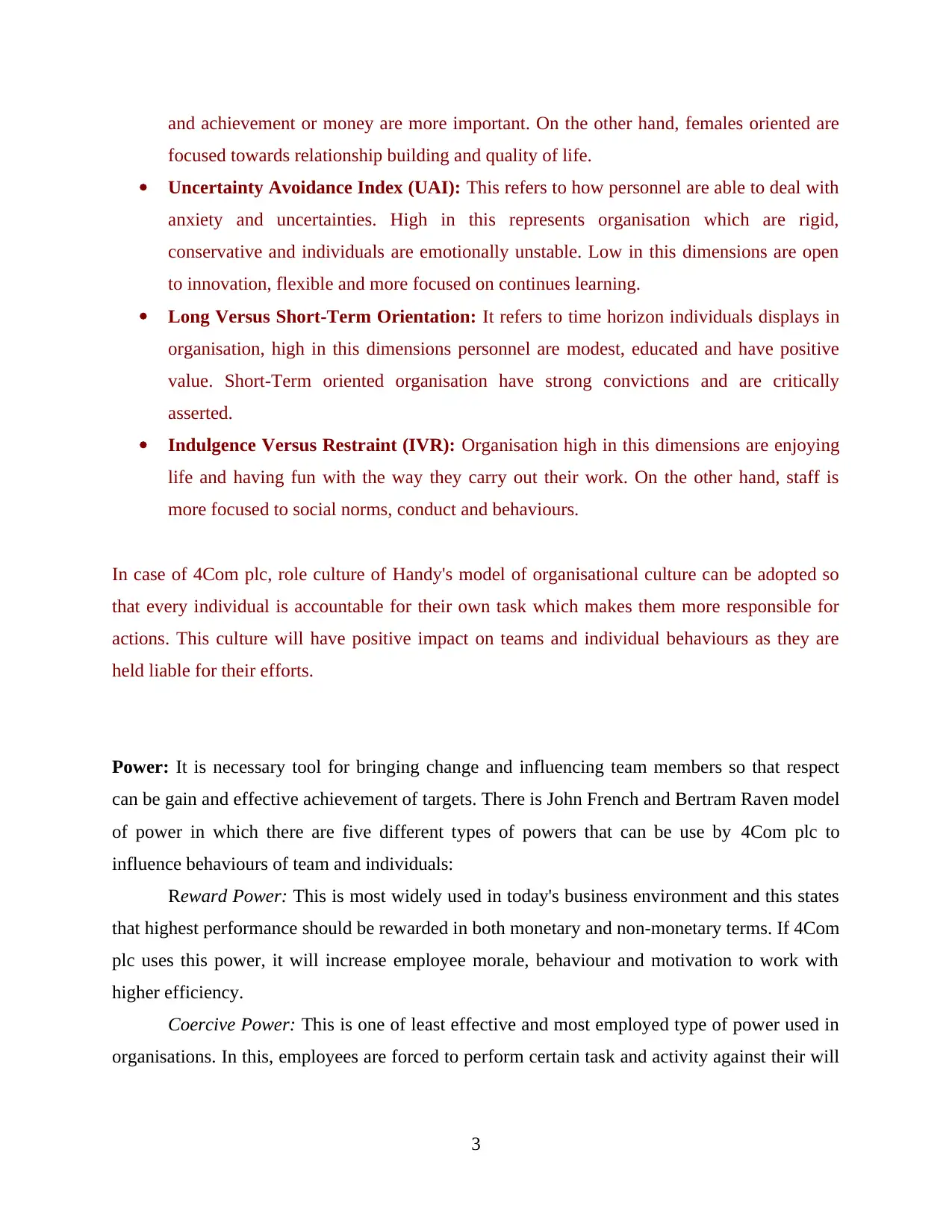
and achievement or money are more important. On the other hand, females oriented are
focused towards relationship building and quality of life.
Uncertainty Avoidance Index (UAI): This refers to how personnel are able to deal with
anxiety and uncertainties. High in this represents organisation which are rigid,
conservative and individuals are emotionally unstable. Low in this dimensions are open
to innovation, flexible and more focused on continues learning.
Long Versus Short-Term Orientation: It refers to time horizon individuals displays in
organisation, high in this dimensions personnel are modest, educated and have positive
value. Short-Term oriented organisation have strong convictions and are critically
asserted.
Indulgence Versus Restraint (IVR): Organisation high in this dimensions are enjoying
life and having fun with the way they carry out their work. On the other hand, staff is
more focused to social norms, conduct and behaviours.
In case of 4Com plc, role culture of Handy's model of organisational culture can be adopted so
that every individual is accountable for their own task which makes them more responsible for
actions. This culture will have positive impact on teams and individual behaviours as they are
held liable for their efforts.
Power: It is necessary tool for bringing change and influencing team members so that respect
can be gain and effective achievement of targets. There is John French and Bertram Raven model
of power in which there are five different types of powers that can be use by 4Com plc to
influence behaviours of team and individuals:
Reward Power: This is most widely used in today's business environment and this states
that highest performance should be rewarded in both monetary and non-monetary terms. If 4Com
plc uses this power, it will increase employee morale, behaviour and motivation to work with
higher efficiency.
Coercive Power: This is one of least effective and most employed type of power used in
organisations. In this, employees are forced to perform certain task and activity against their will
3
focused towards relationship building and quality of life.
Uncertainty Avoidance Index (UAI): This refers to how personnel are able to deal with
anxiety and uncertainties. High in this represents organisation which are rigid,
conservative and individuals are emotionally unstable. Low in this dimensions are open
to innovation, flexible and more focused on continues learning.
Long Versus Short-Term Orientation: It refers to time horizon individuals displays in
organisation, high in this dimensions personnel are modest, educated and have positive
value. Short-Term oriented organisation have strong convictions and are critically
asserted.
Indulgence Versus Restraint (IVR): Organisation high in this dimensions are enjoying
life and having fun with the way they carry out their work. On the other hand, staff is
more focused to social norms, conduct and behaviours.
In case of 4Com plc, role culture of Handy's model of organisational culture can be adopted so
that every individual is accountable for their own task which makes them more responsible for
actions. This culture will have positive impact on teams and individual behaviours as they are
held liable for their efforts.
Power: It is necessary tool for bringing change and influencing team members so that respect
can be gain and effective achievement of targets. There is John French and Bertram Raven model
of power in which there are five different types of powers that can be use by 4Com plc to
influence behaviours of team and individuals:
Reward Power: This is most widely used in today's business environment and this states
that highest performance should be rewarded in both monetary and non-monetary terms. If 4Com
plc uses this power, it will increase employee morale, behaviour and motivation to work with
higher efficiency.
Coercive Power: This is one of least effective and most employed type of power used in
organisations. In this, employees are forced to perform certain task and activity against their will
3
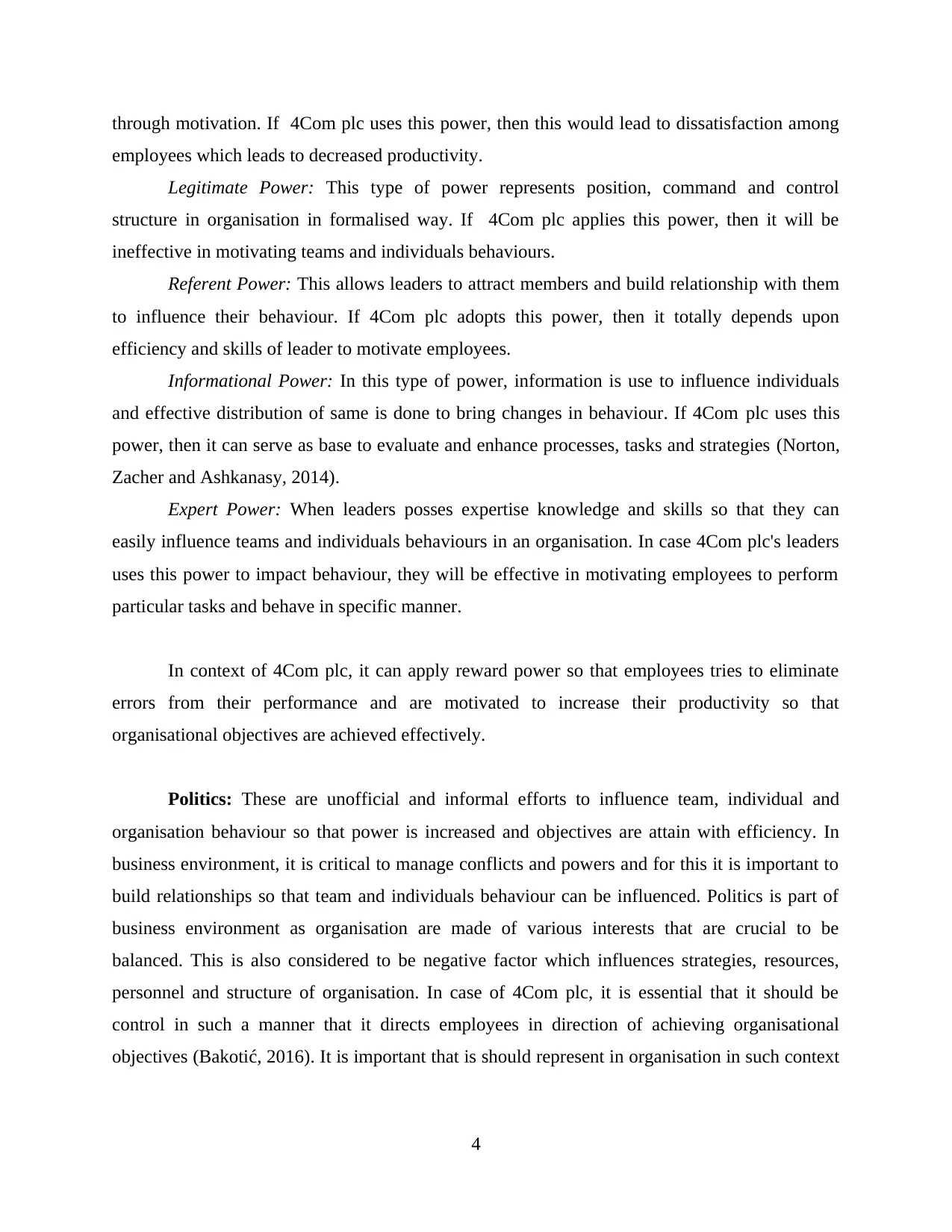
through motivation. If 4Com plc uses this power, then this would lead to dissatisfaction among
employees which leads to decreased productivity.
Legitimate Power: This type of power represents position, command and control
structure in organisation in formalised way. If 4Com plc applies this power, then it will be
ineffective in motivating teams and individuals behaviours.
Referent Power: This allows leaders to attract members and build relationship with them
to influence their behaviour. If 4Com plc adopts this power, then it totally depends upon
efficiency and skills of leader to motivate employees.
Informational Power: In this type of power, information is use to influence individuals
and effective distribution of same is done to bring changes in behaviour. If 4Com plc uses this
power, then it can serve as base to evaluate and enhance processes, tasks and strategies (Norton,
Zacher and Ashkanasy, 2014).
Expert Power: When leaders posses expertise knowledge and skills so that they can
easily influence teams and individuals behaviours in an organisation. In case 4Com plc's leaders
uses this power to impact behaviour, they will be effective in motivating employees to perform
particular tasks and behave in specific manner.
In context of 4Com plc, it can apply reward power so that employees tries to eliminate
errors from their performance and are motivated to increase their productivity so that
organisational objectives are achieved effectively.
Politics: These are unofficial and informal efforts to influence team, individual and
organisation behaviour so that power is increased and objectives are attain with efficiency. In
business environment, it is critical to manage conflicts and powers and for this it is important to
build relationships so that team and individuals behaviour can be influenced. Politics is part of
business environment as organisation are made of various interests that are crucial to be
balanced. This is also considered to be negative factor which influences strategies, resources,
personnel and structure of organisation. In case of 4Com plc, it is essential that it should be
control in such a manner that it directs employees in direction of achieving organisational
objectives (Bakotić, 2016). It is important that is should represent in organisation in such context
4
employees which leads to decreased productivity.
Legitimate Power: This type of power represents position, command and control
structure in organisation in formalised way. If 4Com plc applies this power, then it will be
ineffective in motivating teams and individuals behaviours.
Referent Power: This allows leaders to attract members and build relationship with them
to influence their behaviour. If 4Com plc adopts this power, then it totally depends upon
efficiency and skills of leader to motivate employees.
Informational Power: In this type of power, information is use to influence individuals
and effective distribution of same is done to bring changes in behaviour. If 4Com plc uses this
power, then it can serve as base to evaluate and enhance processes, tasks and strategies (Norton,
Zacher and Ashkanasy, 2014).
Expert Power: When leaders posses expertise knowledge and skills so that they can
easily influence teams and individuals behaviours in an organisation. In case 4Com plc's leaders
uses this power to impact behaviour, they will be effective in motivating employees to perform
particular tasks and behave in specific manner.
In context of 4Com plc, it can apply reward power so that employees tries to eliminate
errors from their performance and are motivated to increase their productivity so that
organisational objectives are achieved effectively.
Politics: These are unofficial and informal efforts to influence team, individual and
organisation behaviour so that power is increased and objectives are attain with efficiency. In
business environment, it is critical to manage conflicts and powers and for this it is important to
build relationships so that team and individuals behaviour can be influenced. Politics is part of
business environment as organisation are made of various interests that are crucial to be
balanced. This is also considered to be negative factor which influences strategies, resources,
personnel and structure of organisation. In case of 4Com plc, it is essential that it should be
control in such a manner that it directs employees in direction of achieving organisational
objectives (Bakotić, 2016). It is important that is should represent in organisation in such context
4
⊘ This is a preview!⊘
Do you want full access?
Subscribe today to unlock all pages.

Trusted by 1+ million students worldwide
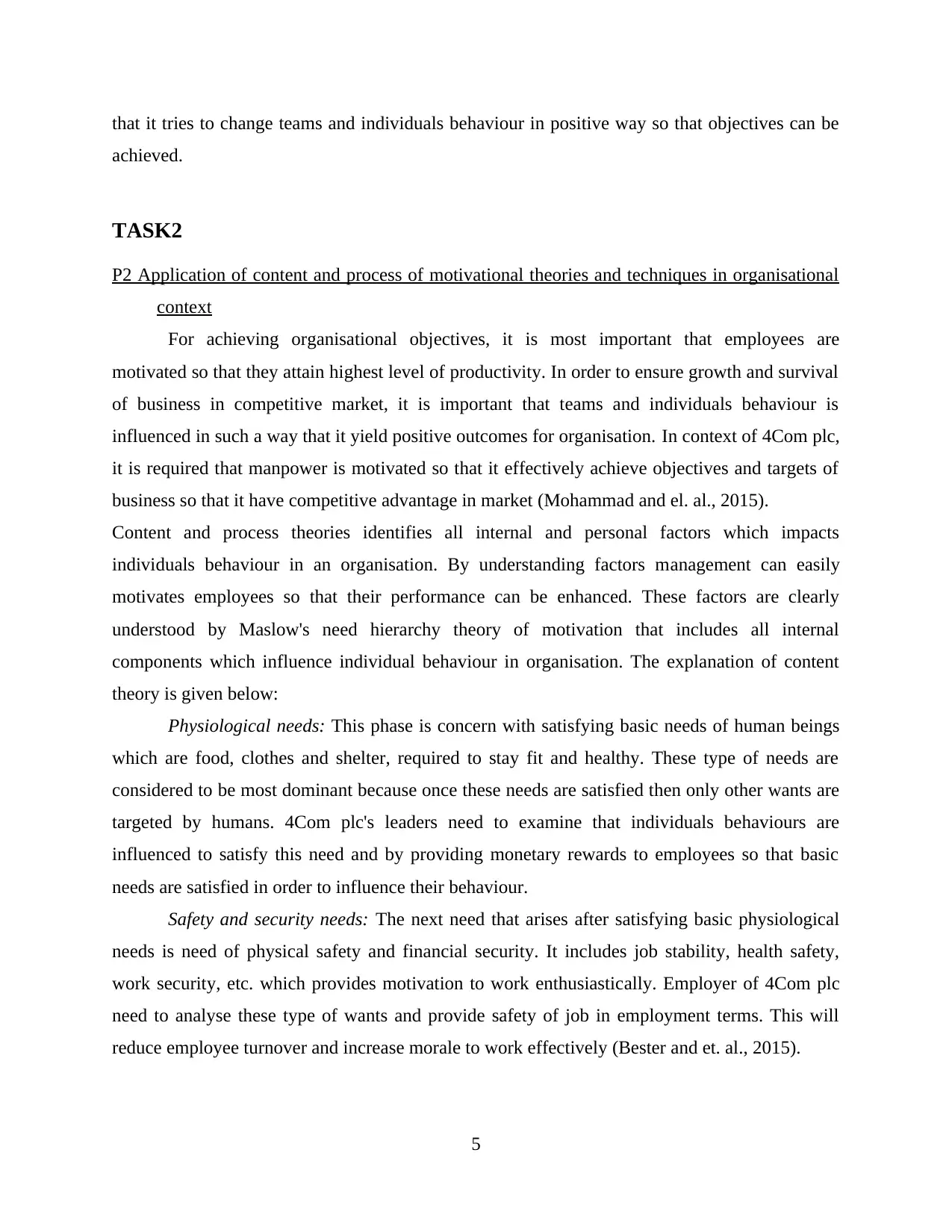
that it tries to change teams and individuals behaviour in positive way so that objectives can be
achieved.
TASK2
P2 Application of content and process of motivational theories and techniques in organisational
context
For achieving organisational objectives, it is most important that employees are
motivated so that they attain highest level of productivity. In order to ensure growth and survival
of business in competitive market, it is important that teams and individuals behaviour is
influenced in such a way that it yield positive outcomes for organisation. In context of 4Com plc,
it is required that manpower is motivated so that it effectively achieve objectives and targets of
business so that it have competitive advantage in market (Mohammad and el. al., 2015).
Content and process theories identifies all internal and personal factors which impacts
individuals behaviour in an organisation. By understanding factors management can easily
motivates employees so that their performance can be enhanced. These factors are clearly
understood by Maslow's need hierarchy theory of motivation that includes all internal
components which influence individual behaviour in organisation. The explanation of content
theory is given below:
Physiological needs: This phase is concern with satisfying basic needs of human beings
which are food, clothes and shelter, required to stay fit and healthy. These type of needs are
considered to be most dominant because once these needs are satisfied then only other wants are
targeted by humans. 4Com plc's leaders need to examine that individuals behaviours are
influenced to satisfy this need and by providing monetary rewards to employees so that basic
needs are satisfied in order to influence their behaviour.
Safety and security needs: The next need that arises after satisfying basic physiological
needs is need of physical safety and financial security. It includes job stability, health safety,
work security, etc. which provides motivation to work enthusiastically. Employer of 4Com plc
need to analyse these type of wants and provide safety of job in employment terms. This will
reduce employee turnover and increase morale to work effectively (Bester and et. al., 2015).
5
achieved.
TASK2
P2 Application of content and process of motivational theories and techniques in organisational
context
For achieving organisational objectives, it is most important that employees are
motivated so that they attain highest level of productivity. In order to ensure growth and survival
of business in competitive market, it is important that teams and individuals behaviour is
influenced in such a way that it yield positive outcomes for organisation. In context of 4Com plc,
it is required that manpower is motivated so that it effectively achieve objectives and targets of
business so that it have competitive advantage in market (Mohammad and el. al., 2015).
Content and process theories identifies all internal and personal factors which impacts
individuals behaviour in an organisation. By understanding factors management can easily
motivates employees so that their performance can be enhanced. These factors are clearly
understood by Maslow's need hierarchy theory of motivation that includes all internal
components which influence individual behaviour in organisation. The explanation of content
theory is given below:
Physiological needs: This phase is concern with satisfying basic needs of human beings
which are food, clothes and shelter, required to stay fit and healthy. These type of needs are
considered to be most dominant because once these needs are satisfied then only other wants are
targeted by humans. 4Com plc's leaders need to examine that individuals behaviours are
influenced to satisfy this need and by providing monetary rewards to employees so that basic
needs are satisfied in order to influence their behaviour.
Safety and security needs: The next need that arises after satisfying basic physiological
needs is need of physical safety and financial security. It includes job stability, health safety,
work security, etc. which provides motivation to work enthusiastically. Employer of 4Com plc
need to analyse these type of wants and provide safety of job in employment terms. This will
reduce employee turnover and increase morale to work effectively (Bester and et. al., 2015).
5
Paraphrase This Document
Need a fresh take? Get an instant paraphrase of this document with our AI Paraphraser
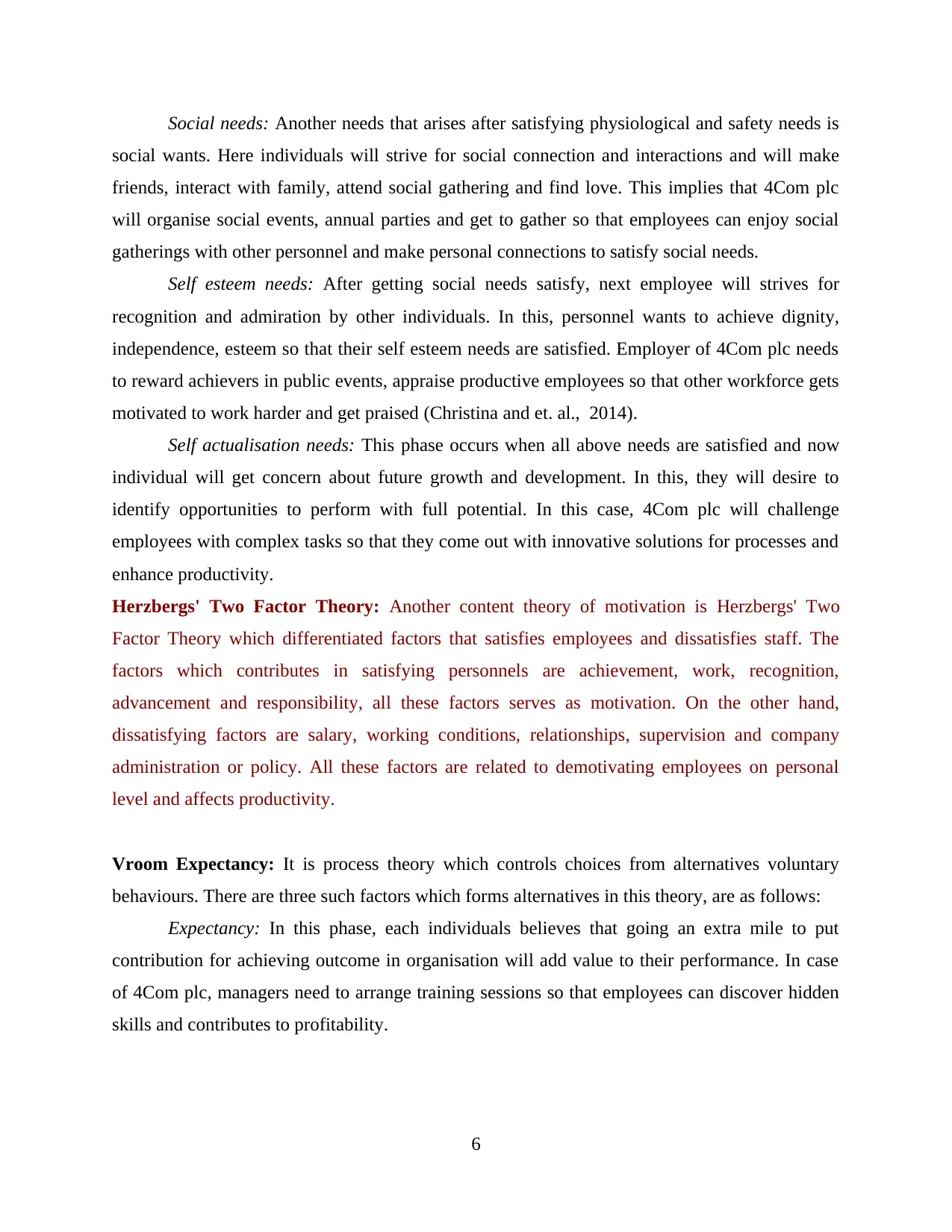
Social needs: Another needs that arises after satisfying physiological and safety needs is
social wants. Here individuals will strive for social connection and interactions and will make
friends, interact with family, attend social gathering and find love. This implies that 4Com plc
will organise social events, annual parties and get to gather so that employees can enjoy social
gatherings with other personnel and make personal connections to satisfy social needs.
Self esteem needs: After getting social needs satisfy, next employee will strives for
recognition and admiration by other individuals. In this, personnel wants to achieve dignity,
independence, esteem so that their self esteem needs are satisfied. Employer of 4Com plc needs
to reward achievers in public events, appraise productive employees so that other workforce gets
motivated to work harder and get praised (Christina and et. al., 2014).
Self actualisation needs: This phase occurs when all above needs are satisfied and now
individual will get concern about future growth and development. In this, they will desire to
identify opportunities to perform with full potential. In this case, 4Com plc will challenge
employees with complex tasks so that they come out with innovative solutions for processes and
enhance productivity.
Herzbergs' Two Factor Theory: Another content theory of motivation is Herzbergs' Two
Factor Theory which differentiated factors that satisfies employees and dissatisfies staff. The
factors which contributes in satisfying personnels are achievement, work, recognition,
advancement and responsibility, all these factors serves as motivation. On the other hand,
dissatisfying factors are salary, working conditions, relationships, supervision and company
administration or policy. All these factors are related to demotivating employees on personal
level and affects productivity.
Vroom Expectancy: It is process theory which controls choices from alternatives voluntary
behaviours. There are three such factors which forms alternatives in this theory, are as follows:
Expectancy: In this phase, each individuals believes that going an extra mile to put
contribution for achieving outcome in organisation will add value to their performance. In case
of 4Com plc, managers need to arrange training sessions so that employees can discover hidden
skills and contributes to profitability.
6
social wants. Here individuals will strive for social connection and interactions and will make
friends, interact with family, attend social gathering and find love. This implies that 4Com plc
will organise social events, annual parties and get to gather so that employees can enjoy social
gatherings with other personnel and make personal connections to satisfy social needs.
Self esteem needs: After getting social needs satisfy, next employee will strives for
recognition and admiration by other individuals. In this, personnel wants to achieve dignity,
independence, esteem so that their self esteem needs are satisfied. Employer of 4Com plc needs
to reward achievers in public events, appraise productive employees so that other workforce gets
motivated to work harder and get praised (Christina and et. al., 2014).
Self actualisation needs: This phase occurs when all above needs are satisfied and now
individual will get concern about future growth and development. In this, they will desire to
identify opportunities to perform with full potential. In this case, 4Com plc will challenge
employees with complex tasks so that they come out with innovative solutions for processes and
enhance productivity.
Herzbergs' Two Factor Theory: Another content theory of motivation is Herzbergs' Two
Factor Theory which differentiated factors that satisfies employees and dissatisfies staff. The
factors which contributes in satisfying personnels are achievement, work, recognition,
advancement and responsibility, all these factors serves as motivation. On the other hand,
dissatisfying factors are salary, working conditions, relationships, supervision and company
administration or policy. All these factors are related to demotivating employees on personal
level and affects productivity.
Vroom Expectancy: It is process theory which controls choices from alternatives voluntary
behaviours. There are three such factors which forms alternatives in this theory, are as follows:
Expectancy: In this phase, each individuals believes that going an extra mile to put
contribution for achieving outcome in organisation will add value to their performance. In case
of 4Com plc, managers need to arrange training sessions so that employees can discover hidden
skills and contributes to profitability.
6
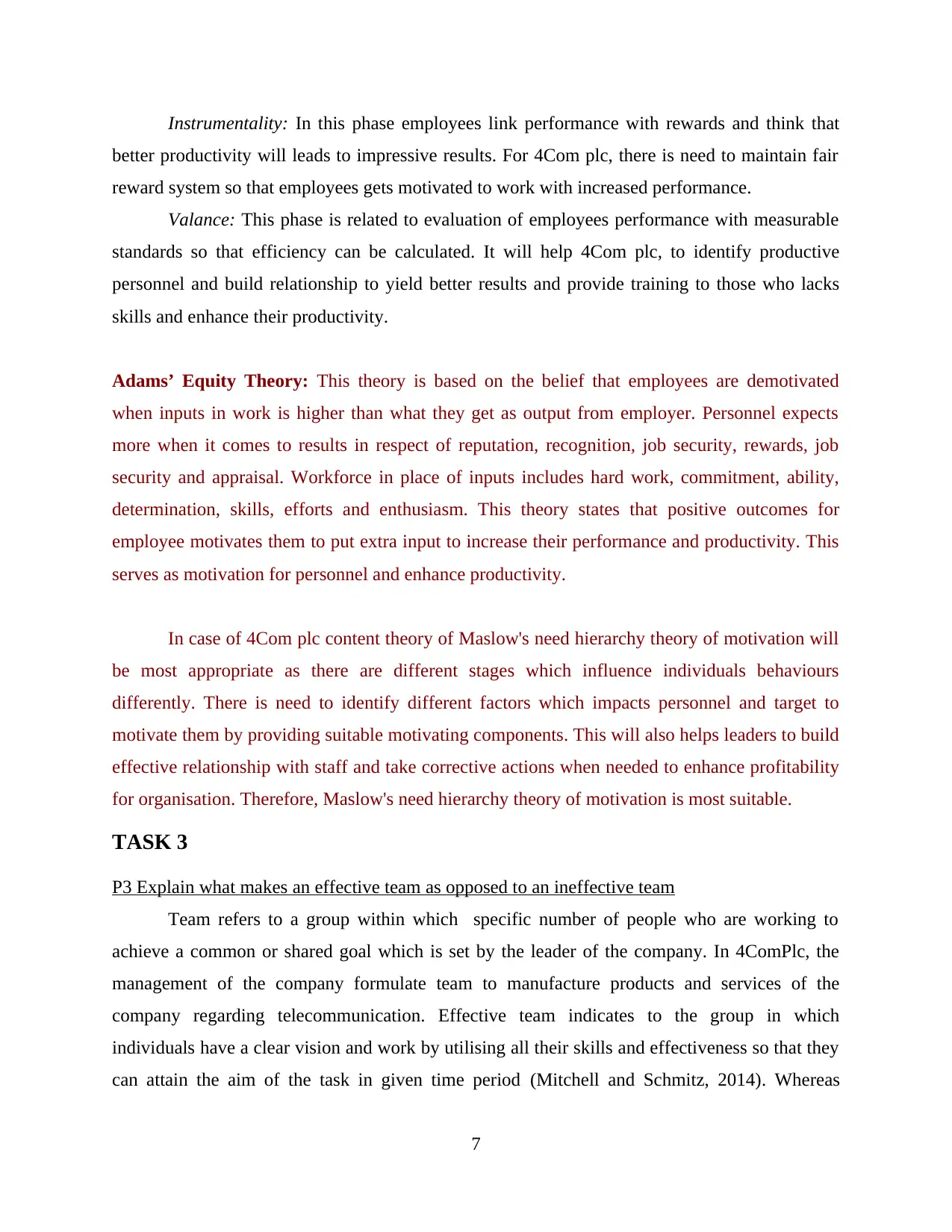
Instrumentality: In this phase employees link performance with rewards and think that
better productivity will leads to impressive results. For 4Com plc, there is need to maintain fair
reward system so that employees gets motivated to work with increased performance.
Valance: This phase is related to evaluation of employees performance with measurable
standards so that efficiency can be calculated. It will help 4Com plc, to identify productive
personnel and build relationship to yield better results and provide training to those who lacks
skills and enhance their productivity.
Adams’ Equity Theory: This theory is based on the belief that employees are demotivated
when inputs in work is higher than what they get as output from employer. Personnel expects
more when it comes to results in respect of reputation, recognition, job security, rewards, job
security and appraisal. Workforce in place of inputs includes hard work, commitment, ability,
determination, skills, efforts and enthusiasm. This theory states that positive outcomes for
employee motivates them to put extra input to increase their performance and productivity. This
serves as motivation for personnel and enhance productivity.
In case of 4Com plc content theory of Maslow's need hierarchy theory of motivation will
be most appropriate as there are different stages which influence individuals behaviours
differently. There is need to identify different factors which impacts personnel and target to
motivate them by providing suitable motivating components. This will also helps leaders to build
effective relationship with staff and take corrective actions when needed to enhance profitability
for organisation. Therefore, Maslow's need hierarchy theory of motivation is most suitable.
TASK 3
P3 Explain what makes an effective team as opposed to an ineffective team
Team refers to a group within which specific number of people who are working to
achieve a common or shared goal which is set by the leader of the company. In 4ComPlc, the
management of the company formulate team to manufacture products and services of the
company regarding telecommunication. Effective team indicates to the group in which
individuals have a clear vision and work by utilising all their skills and effectiveness so that they
can attain the aim of the task in given time period (Mitchell and Schmitz, 2014). Whereas
7
better productivity will leads to impressive results. For 4Com plc, there is need to maintain fair
reward system so that employees gets motivated to work with increased performance.
Valance: This phase is related to evaluation of employees performance with measurable
standards so that efficiency can be calculated. It will help 4Com plc, to identify productive
personnel and build relationship to yield better results and provide training to those who lacks
skills and enhance their productivity.
Adams’ Equity Theory: This theory is based on the belief that employees are demotivated
when inputs in work is higher than what they get as output from employer. Personnel expects
more when it comes to results in respect of reputation, recognition, job security, rewards, job
security and appraisal. Workforce in place of inputs includes hard work, commitment, ability,
determination, skills, efforts and enthusiasm. This theory states that positive outcomes for
employee motivates them to put extra input to increase their performance and productivity. This
serves as motivation for personnel and enhance productivity.
In case of 4Com plc content theory of Maslow's need hierarchy theory of motivation will
be most appropriate as there are different stages which influence individuals behaviours
differently. There is need to identify different factors which impacts personnel and target to
motivate them by providing suitable motivating components. This will also helps leaders to build
effective relationship with staff and take corrective actions when needed to enhance profitability
for organisation. Therefore, Maslow's need hierarchy theory of motivation is most suitable.
TASK 3
P3 Explain what makes an effective team as opposed to an ineffective team
Team refers to a group within which specific number of people who are working to
achieve a common or shared goal which is set by the leader of the company. In 4ComPlc, the
management of the company formulate team to manufacture products and services of the
company regarding telecommunication. Effective team indicates to the group in which
individuals have a clear vision and work by utilising all their skills and effectiveness so that they
can attain the aim of the task in given time period (Mitchell and Schmitz, 2014). Whereas
7
⊘ This is a preview!⊘
Do you want full access?
Subscribe today to unlock all pages.

Trusted by 1+ million students worldwide
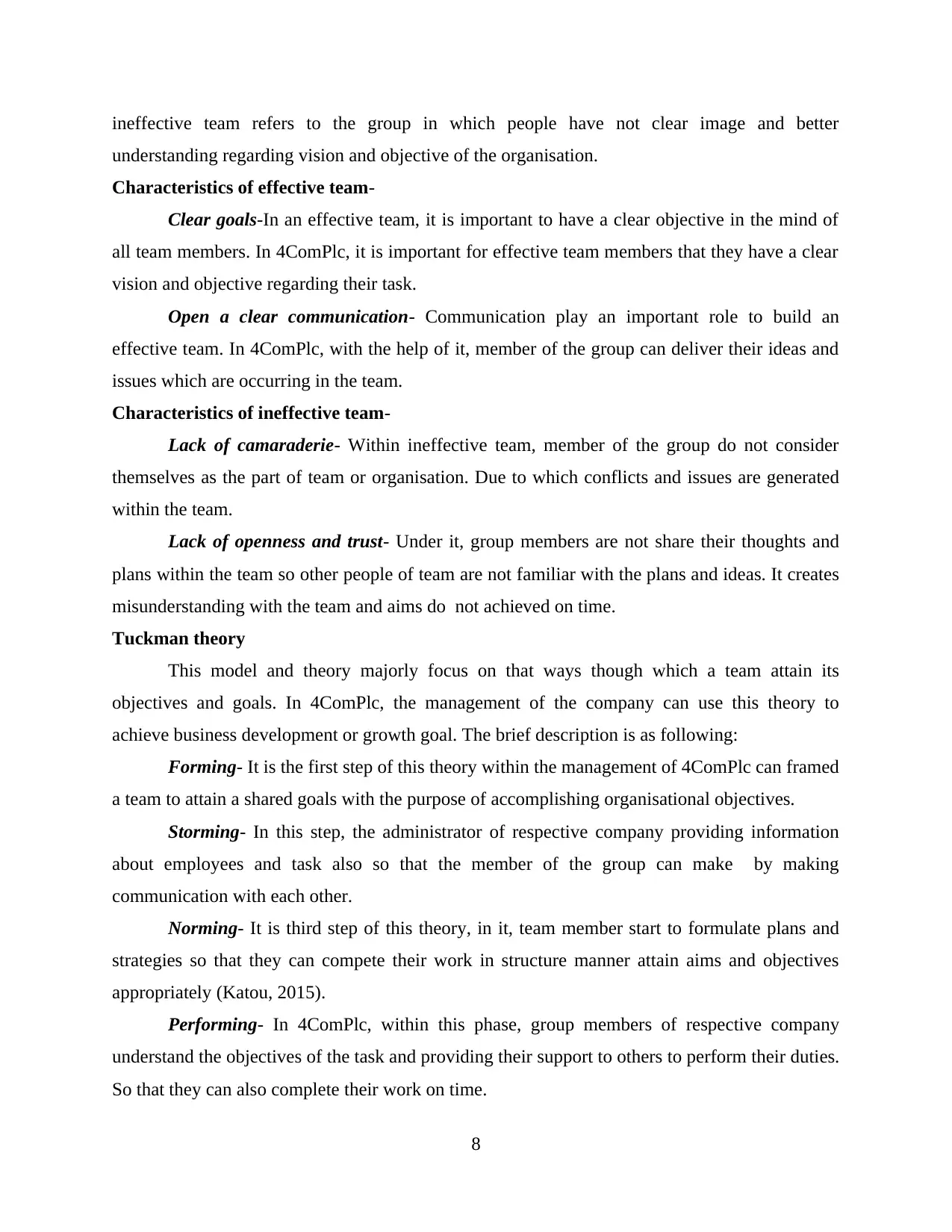
ineffective team refers to the group in which people have not clear image and better
understanding regarding vision and objective of the organisation.
Characteristics of effective team-
Clear goals-In an effective team, it is important to have a clear objective in the mind of
all team members. In 4ComPlc, it is important for effective team members that they have a clear
vision and objective regarding their task.
Open a clear communication- Communication play an important role to build an
effective team. In 4ComPlc, with the help of it, member of the group can deliver their ideas and
issues which are occurring in the team.
Characteristics of ineffective team-
Lack of camaraderie- Within ineffective team, member of the group do not consider
themselves as the part of team or organisation. Due to which conflicts and issues are generated
within the team.
Lack of openness and trust- Under it, group members are not share their thoughts and
plans within the team so other people of team are not familiar with the plans and ideas. It creates
misunderstanding with the team and aims do not achieved on time.
Tuckman theory
This model and theory majorly focus on that ways though which a team attain its
objectives and goals. In 4ComPlc, the management of the company can use this theory to
achieve business development or growth goal. The brief description is as following:
Forming- It is the first step of this theory within the management of 4ComPlc can framed
a team to attain a shared goals with the purpose of accomplishing organisational objectives.
Storming- In this step, the administrator of respective company providing information
about employees and task also so that the member of the group can make by making
communication with each other.
Norming- It is third step of this theory, in it, team member start to formulate plans and
strategies so that they can compete their work in structure manner attain aims and objectives
appropriately (Katou, 2015).
Performing- In 4ComPlc, within this phase, group members of respective company
understand the objectives of the task and providing their support to others to perform their duties.
So that they can also complete their work on time.
8
understanding regarding vision and objective of the organisation.
Characteristics of effective team-
Clear goals-In an effective team, it is important to have a clear objective in the mind of
all team members. In 4ComPlc, it is important for effective team members that they have a clear
vision and objective regarding their task.
Open a clear communication- Communication play an important role to build an
effective team. In 4ComPlc, with the help of it, member of the group can deliver their ideas and
issues which are occurring in the team.
Characteristics of ineffective team-
Lack of camaraderie- Within ineffective team, member of the group do not consider
themselves as the part of team or organisation. Due to which conflicts and issues are generated
within the team.
Lack of openness and trust- Under it, group members are not share their thoughts and
plans within the team so other people of team are not familiar with the plans and ideas. It creates
misunderstanding with the team and aims do not achieved on time.
Tuckman theory
This model and theory majorly focus on that ways though which a team attain its
objectives and goals. In 4ComPlc, the management of the company can use this theory to
achieve business development or growth goal. The brief description is as following:
Forming- It is the first step of this theory within the management of 4ComPlc can framed
a team to attain a shared goals with the purpose of accomplishing organisational objectives.
Storming- In this step, the administrator of respective company providing information
about employees and task also so that the member of the group can make by making
communication with each other.
Norming- It is third step of this theory, in it, team member start to formulate plans and
strategies so that they can compete their work in structure manner attain aims and objectives
appropriately (Katou, 2015).
Performing- In 4ComPlc, within this phase, group members of respective company
understand the objectives of the task and providing their support to others to perform their duties.
So that they can also complete their work on time.
8
Paraphrase This Document
Need a fresh take? Get an instant paraphrase of this document with our AI Paraphraser
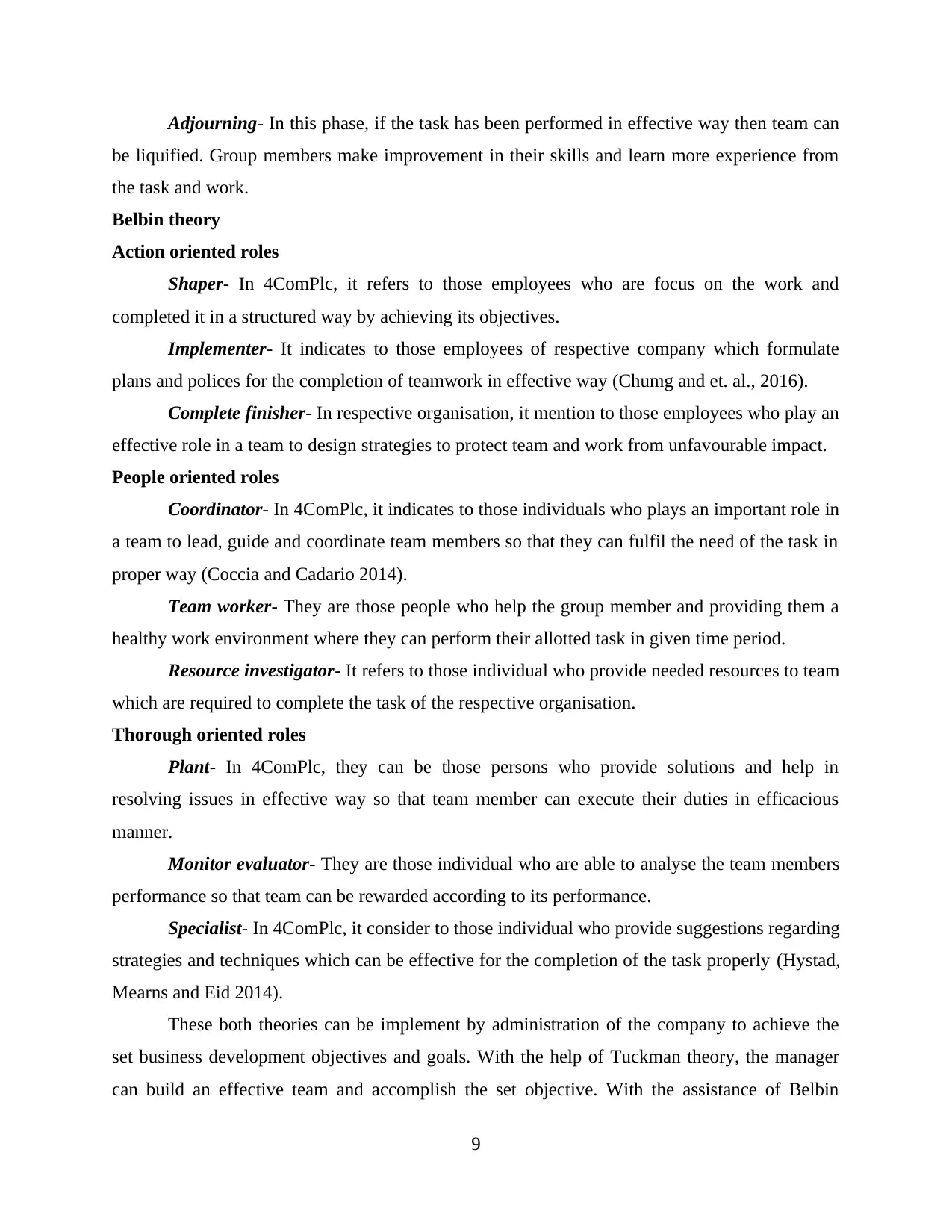
Adjourning- In this phase, if the task has been performed in effective way then team can
be liquified. Group members make improvement in their skills and learn more experience from
the task and work.
Belbin theory
Action oriented roles
Shaper- In 4ComPlc, it refers to those employees who are focus on the work and
completed it in a structured way by achieving its objectives.
Implementer- It indicates to those employees of respective company which formulate
plans and polices for the completion of teamwork in effective way (Chumg and et. al., 2016).
Complete finisher- In respective organisation, it mention to those employees who play an
effective role in a team to design strategies to protect team and work from unfavourable impact.
People oriented roles
Coordinator- In 4ComPlc, it indicates to those individuals who plays an important role in
a team to lead, guide and coordinate team members so that they can fulfil the need of the task in
proper way (Coccia and Cadario 2014).
Team worker- They are those people who help the group member and providing them a
healthy work environment where they can perform their allotted task in given time period.
Resource investigator- It refers to those individual who provide needed resources to team
which are required to complete the task of the respective organisation.
Thorough oriented roles
Plant- In 4ComPlc, they can be those persons who provide solutions and help in
resolving issues in effective way so that team member can execute their duties in efficacious
manner.
Monitor evaluator- They are those individual who are able to analyse the team members
performance so that team can be rewarded according to its performance.
Specialist- In 4ComPlc, it consider to those individual who provide suggestions regarding
strategies and techniques which can be effective for the completion of the task properly (Hystad,
Mearns and Eid 2014).
These both theories can be implement by administration of the company to achieve the
set business development objectives and goals. With the help of Tuckman theory, the manager
can build an effective team and accomplish the set objective. With the assistance of Belbin
9
be liquified. Group members make improvement in their skills and learn more experience from
the task and work.
Belbin theory
Action oriented roles
Shaper- In 4ComPlc, it refers to those employees who are focus on the work and
completed it in a structured way by achieving its objectives.
Implementer- It indicates to those employees of respective company which formulate
plans and polices for the completion of teamwork in effective way (Chumg and et. al., 2016).
Complete finisher- In respective organisation, it mention to those employees who play an
effective role in a team to design strategies to protect team and work from unfavourable impact.
People oriented roles
Coordinator- In 4ComPlc, it indicates to those individuals who plays an important role in
a team to lead, guide and coordinate team members so that they can fulfil the need of the task in
proper way (Coccia and Cadario 2014).
Team worker- They are those people who help the group member and providing them a
healthy work environment where they can perform their allotted task in given time period.
Resource investigator- It refers to those individual who provide needed resources to team
which are required to complete the task of the respective organisation.
Thorough oriented roles
Plant- In 4ComPlc, they can be those persons who provide solutions and help in
resolving issues in effective way so that team member can execute their duties in efficacious
manner.
Monitor evaluator- They are those individual who are able to analyse the team members
performance so that team can be rewarded according to its performance.
Specialist- In 4ComPlc, it consider to those individual who provide suggestions regarding
strategies and techniques which can be effective for the completion of the task properly (Hystad,
Mearns and Eid 2014).
These both theories can be implement by administration of the company to achieve the
set business development objectives and goals. With the help of Tuckman theory, the manager
can build an effective team and accomplish the set objective. With the assistance of Belbin
9
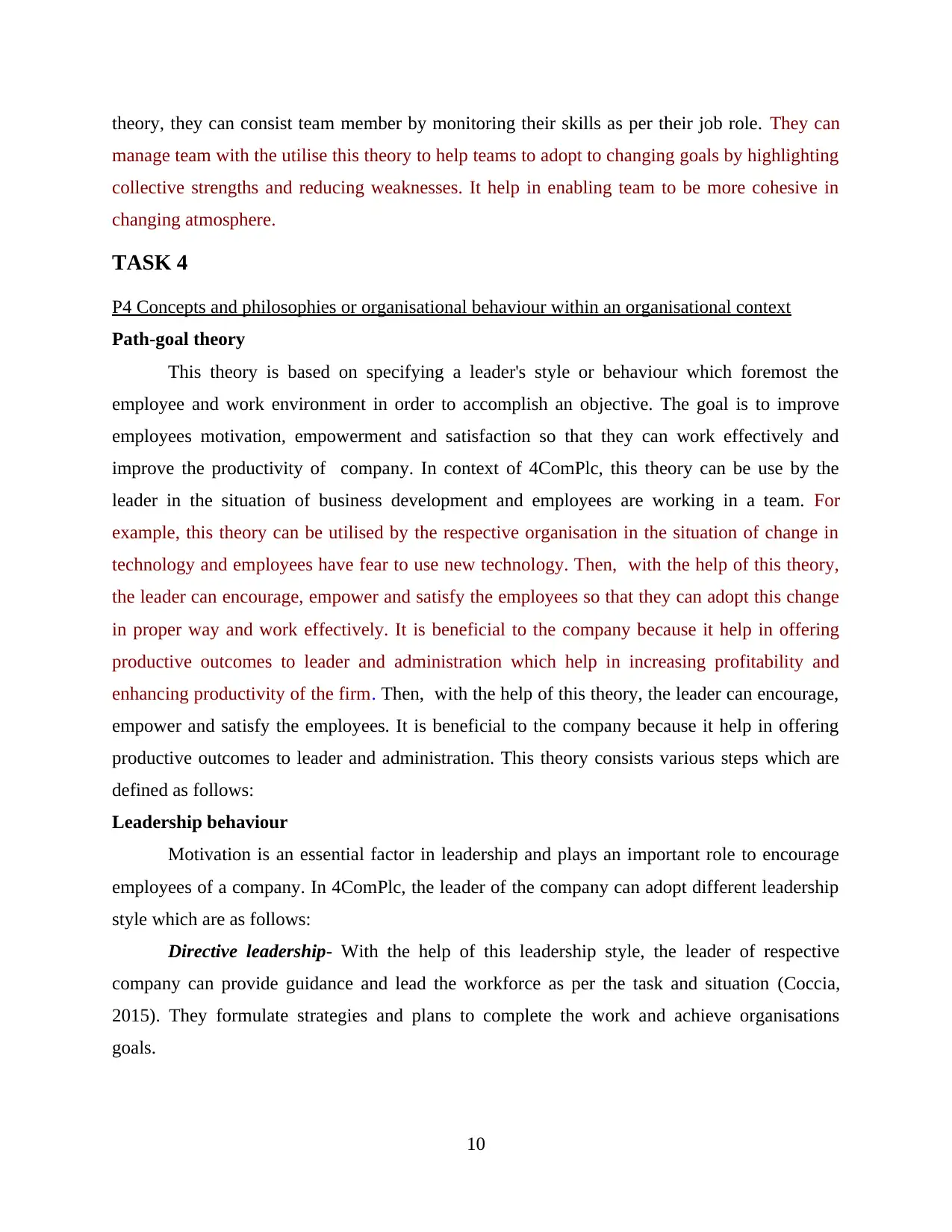
theory, they can consist team member by monitoring their skills as per their job role. They can
manage team with the utilise this theory to help teams to adopt to changing goals by highlighting
collective strengths and reducing weaknesses. It help in enabling team to be more cohesive in
changing atmosphere.
TASK 4
P4 Concepts and philosophies or organisational behaviour within an organisational context
Path-goal theory
This theory is based on specifying a leader's style or behaviour which foremost the
employee and work environment in order to accomplish an objective. The goal is to improve
employees motivation, empowerment and satisfaction so that they can work effectively and
improve the productivity of company. In context of 4ComPlc, this theory can be use by the
leader in the situation of business development and employees are working in a team. For
example, this theory can be utilised by the respective organisation in the situation of change in
technology and employees have fear to use new technology. Then, with the help of this theory,
the leader can encourage, empower and satisfy the employees so that they can adopt this change
in proper way and work effectively. It is beneficial to the company because it help in offering
productive outcomes to leader and administration which help in increasing profitability and
enhancing productivity of the firm. Then, with the help of this theory, the leader can encourage,
empower and satisfy the employees. It is beneficial to the company because it help in offering
productive outcomes to leader and administration. This theory consists various steps which are
defined as follows:
Leadership behaviour
Motivation is an essential factor in leadership and plays an important role to encourage
employees of a company. In 4ComPlc, the leader of the company can adopt different leadership
style which are as follows:
Directive leadership- With the help of this leadership style, the leader of respective
company can provide guidance and lead the workforce as per the task and situation (Coccia,
2015). They formulate strategies and plans to complete the work and achieve organisations
goals.
10
manage team with the utilise this theory to help teams to adopt to changing goals by highlighting
collective strengths and reducing weaknesses. It help in enabling team to be more cohesive in
changing atmosphere.
TASK 4
P4 Concepts and philosophies or organisational behaviour within an organisational context
Path-goal theory
This theory is based on specifying a leader's style or behaviour which foremost the
employee and work environment in order to accomplish an objective. The goal is to improve
employees motivation, empowerment and satisfaction so that they can work effectively and
improve the productivity of company. In context of 4ComPlc, this theory can be use by the
leader in the situation of business development and employees are working in a team. For
example, this theory can be utilised by the respective organisation in the situation of change in
technology and employees have fear to use new technology. Then, with the help of this theory,
the leader can encourage, empower and satisfy the employees so that they can adopt this change
in proper way and work effectively. It is beneficial to the company because it help in offering
productive outcomes to leader and administration which help in increasing profitability and
enhancing productivity of the firm. Then, with the help of this theory, the leader can encourage,
empower and satisfy the employees. It is beneficial to the company because it help in offering
productive outcomes to leader and administration. This theory consists various steps which are
defined as follows:
Leadership behaviour
Motivation is an essential factor in leadership and plays an important role to encourage
employees of a company. In 4ComPlc, the leader of the company can adopt different leadership
style which are as follows:
Directive leadership- With the help of this leadership style, the leader of respective
company can provide guidance and lead the workforce as per the task and situation (Coccia,
2015). They formulate strategies and plans to complete the work and achieve organisations
goals.
10
⊘ This is a preview!⊘
Do you want full access?
Subscribe today to unlock all pages.

Trusted by 1+ million students worldwide
1 out of 17
Related Documents
Your All-in-One AI-Powered Toolkit for Academic Success.
+13062052269
info@desklib.com
Available 24*7 on WhatsApp / Email
![[object Object]](/_next/static/media/star-bottom.7253800d.svg)
Unlock your academic potential
Copyright © 2020–2025 A2Z Services. All Rights Reserved. Developed and managed by ZUCOL.





